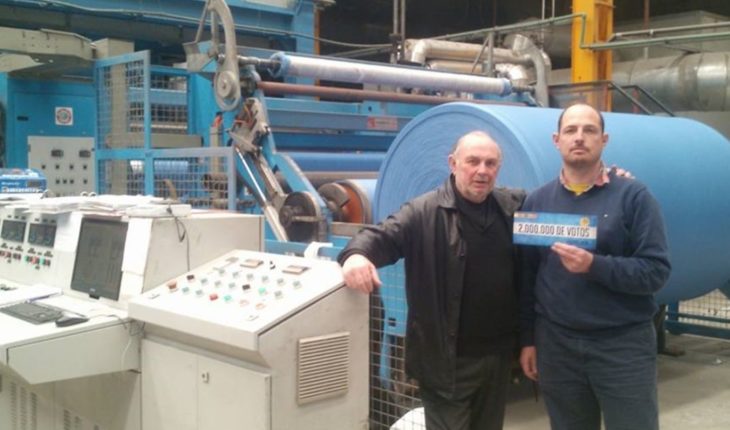the Government insists with the labor reform, however social rejection is broad and don’t get enough Congressional support. The new strategy, to the demands of the agreement signed with the International Monetary Fund, has to do with implementing it through sectoral agreements, bypassing the legislature. To learn more about the sector Filo.News interviewed Raúl Hutin, SME textile leader makes more than 50 years, the Central of entities entrepreneurs National Secretary, Vice President of the industrial Union of Moreno and member of the foundation Pro weave.
“This maneuver that tried the Government put a Trojan horse through the most hit sector, textile, is a maneuver where everyone loses.” exclaims the SME entrepreneur.
The first attempt was in the textile industry, one of the hardest hit by the recession that is still ongoing. According to the textile leader the item shows with excess capacity from its historical average more than 20 points. The latest data from INDEC, of November 2018, show that the use of textile capacity was slightly higher than 40%, less than half of its real potential. The employer ensures that it will be worse for December, January and February where “this all braking”. The labor reform agreement commitment to production and employment in the textile industry and clothing, overtaken by Mariano Martin to ambito.com, goes in the same direction that reform labour integral presented by the Executive last year: lower compensation through the”termination”.
Lower vacation pay and bonus enabling payment in installments.
Flexible hours of work with “hours Bank”.
Regulate home work.
In the words of Hutin, the agreement “aims to destroy the conditions of work and pauperizar the salary of the people. Each save for their own compensation, there is a Bank of hours for which the worker is at the disposal of the employer, an almost slavish regime which also erases the overtime.” In the same sense, the regularization of home work is not less since it would be passed to legalize forms of labour that border on slavery. We must bear in mind that in the textile manufacturing informality exceeds by more than 20 points the average of the Argentine economy and accumulate complaints about work slave above all of the major brands.
“Won the battle but not the war” but even in this completely discouraging Outlook for textile SMEs strategy had a first failed attempt and promises of improvements from the agreement were unsuccessful. In this case, the rejection came both workers and employers.
“They will continue attempts to advance by the pressures of the IMF, we are going to keep fighting it. Interesting thing is that for the first time trade unions and entrepreneurs come together in the same goal, being the only way possible to emerge from this crisis,”predicts Hutin.
Moreover, employers made it clear that it is not what they need. Their problems have nothing to do with the so widespread cost labour but with a domestic market does not respond, with a credit that is precluded by the high interest rates to keep the dollar stable and rates dollarized that more expensive throughout the production chain.
“Textile sells almost exclusively to the domestic market, we need that people have to be able to purchasing so that you can buy a duds but can not work more”, emphasizes the leader.
External front doesn’t seem better, “between 2007 and 2017, the number of SMEs that exported fell 50% and we do not fell more, myself, because we want to keep that door open with customers that we get. It is becoming more difficult, today we are paying to export 12% surcharge, if we add that the rates, will then be impossible to also export. “I cerrás the internal market and the external and then I have to close the factory.” Is there a 2019?
What is worrying scenario is that they do not appear to have intentions to improve the heart of the problem: the precipitous decline of consumption. “There is no engine for production” in the words of Hutin. The SME entrepreneur denounces the Government’s only interest is to maintain a stable dollar, with high rates of interest that confers and the recession we are experiencing.
As for the prospects for this year, the leader of the textile sector sees continuity in the loss of purchasing power. “Still optimistic we can think of inflation that ronde 40% and the joint being discussed around 23%. Even if they reach the 30% they will lose against rising prices”. Each fall the purchasing power is a hit in the pocket of people and new shrinking of an internal market where 98% of the SMEs textile production is tipped.
Does anyone believe that Dante Sica, man experienced in the industrial theme, don’t know how to reactivate the productive?. Do not know that with the fall of real wages, not you can have market internal, unaware that imports are not halted. Don’t know that rates to 80% NO VAN – Raul Hutin (@RaulHutin) 28 January of 2019 at the same time, the growing stock of Leliqs (letters from liquidity) also marks the limits keep the dollar at that cost. “The markets know that the Government does not have the conditions necessary and sufficient to deal with the millions of Leliqs that is broadcast and is going to turn.” We estimate that it will be in June, the markets being carried out because you’re not going is to play.” In this note:





